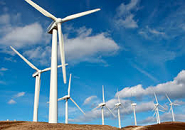Environment and Energy

Commerce Pushes Towards Offshore Wind Energy
Written by David Schollaert
April 6, 2021
U.S. Secretary of Commerce Gina Raimondo announced two new initiatives the Biden administration is taking to advance its clean energy goals. They consist of offshore wind power generation and a data-sharing agreement between the National Oceanic and Atmospheric Administration (NOAA) and Ørsted Wind Power North America LLC, an offshore wind developer.
The administration’s renewable resource goal–a significant portion of Biden’s $2 trillion infrastructure bill–is to reshape the U.S. economy and build out a clean energy infrastructure. Part of that endeavor is to tap into the potential of offshore wind power generation, combat the climate crisis and create more clean energy jobs. These efforts alone could add nearly 100,000 new union jobs by 2030 in offshore power generation and communities supported by offshore wind activity, according to government estimates.
“These actions illustrate the Department’s commitment to innovative partnerships to advance the best science and data that will ensure the development of offshore wind is transparent and inclusive of all stakeholders,” said Secretary Raimondo. “We look forward to working across the public and private sectors to invest in clean energy solutions, like offshore wind, that will contribute to our whole-of-government approach to combat the climate emergency and create high-paying, high-skilled American jobs.”
According to the announcement, the DOC, along with the Departments of Interior and Energy, have a shared goal with this initiative to deploy 30 gigawatts (GW) of offshore wind in the U.S. by 2030. By meeting this ambitious target, more than $12 billion in annual capital investment will be spent in projects on both U.S. coasts, and tens of thousands of new jobs will be added to the economy. Additionally, it will also generate enough power to meet the demand of more than 10 million American homes for a year and avoid 78 million metric tons of CO2 emissions, the administration claims.
The DOC also noted that the NOAA has entered an information sharing agreement with Ørsted Wind Power North America LLC. The goal is to ensure that offshore renewable energy technologies and infrastructure are developed, deployed and maintained effectively. The memorandum is the first data-sharing agreement between an offshore wind developer and the NOAA.
The use of fossil fuels and the conventional methods of producing electricity will diminish drastically over the next 50 years, experts predict, and the infrastructure bill proposed by the Biden administration last week calls for renewable energy to be a key part of the new clean energy economy. Steel will be a major contributing factor to the development of renewable energy, and likely a strategic choice. Steel use in wind energy varies significantly, especially between towers, blades and turbines. Although turbines and blades don’t use much steel, existing wind towers use upwards of 180 tons of heavy plate. The offshore wind power generation initiative by the Biden administration should certainly have a direct impact on the steel marketplace.
By David Schollaert, David@SteelMarketUpdate.com

David Schollaert
Read more from David SchollaertLatest in Environment and Energy

AISI announces publication of environmental rules for N. American steel construction products
The American Iron and Steel Institute (AISI) has announced the publication of the third version of the Product Category Rules (PCR) for North American Steel Construction Products.

Reports: Federal funding for Cliffs’ project could be slashed
Elon Musk's DOGE is determining which Department of Energy grants to advance and which ones to terminate, according to several media outlets

Flack’s Fabral launches solar division
The metal roofing manufacturer is launching Fabral Solar to integrate solar technology within commercial, residential, and agricultural structures.

Trump intends to declare ‘national energy emergency,’ focus on fossil fuels
The incoming administration said it also wants to streamline permitting and roll back regulations.

Nucor carbon targets certified by GSCC
Nucor’s “ambitious” carbon targets by the end of the decade and beyond have been certified by the Global Steel Climate Council (GSCC). The Charlotte, N.C.-based steelmaker used a base year of 2023 for its science-based emissions targets (SBET). It set an SBET of 0.975 metric tons (mt) of CO2 emissions per mt of hot-rolled steel […]
